Meandering Characteristics of the Yimin River in Hulun Buir Grassland, Inner Mongolia, China
Abstract
:1. Introduction
2. Materials and Methods
2.1. Study Area
2.2. Dataset and Methods
2.2.1. Remote Sensing Images
2.2.2. Channel Planform Geometric Parameters
3. Results
3.1. Channel Geometric Parameters
3.2. Skewing Direction and Sinuosity Index
3.3. Skewing Direction and Sinuosity Index in High-Amplitude Bends
4. Discussion
5. Conclusions
Author Contributions
Funding
Acknowledgments
Conflicts of Interest
References
- Lewis, C.T.; Short, C. A Latin Dictionary Founded on Andrews’ Edition of Freund’s Latin Dictionary; Clarendon Press: Oxford, UK, 1922. [Google Scholar]
- Strabo. The Geography of Strabo; Jones, H.L., Ed.; Harvard University Press: Cambridge, MA, USA; William Heinemann, Ltd.: London, UK, 1924. [Google Scholar]
- Inci, G.; Abad, J.D.; Zolezzi, G.; Hooke, J. Advances and challenges in meandering channels research. Geomorphology 2012, 163, 1–9. [Google Scholar] [CrossRef]
- Baker, V.R. Sinuous rivers. Proc. Natl. Acad. Sci. USA 2013, 110, 8321–8322. [Google Scholar] [CrossRef] [PubMed] [Green Version]
- Hooke, J.M. Changes in river meanders: A review of techniques and results of analyses. Prog. Phys. Geogr. 1984, 8, 473–508. [Google Scholar] [CrossRef]
- Ielpi, A.; Lapôtre, M.G.A. A tenfold slowdown in river meander migration driven by plant life. Nat. Geosci. 2020, 13, 82–86. [Google Scholar] [CrossRef]
- Schumm, S.A.; Spitz, W.J. Geological influences on the Lower Mississippi River and its alluvial valley. Eng. Geol. 1996, 45, 245–261. [Google Scholar] [CrossRef]
- Yousefi, S.; Pourghasemi, H.R.; Hooke, J.; Navratil, O.; Kidová, A. Changes in morphometric meander parameters identified on the Karoon River, Iran, using remote sensing data. Geomorphology 2016, 271, 55–64. [Google Scholar] [CrossRef] [Green Version]
- Elliott, C.M. River Meandering. In Proceedings of the Conference Rivers ’83, New Orleans, LA, USA, 24–26 October 1986. [Google Scholar]
- Einstein, A. Die Ursache der Meandebildung der Flusslaufe und des sogenannten Baerschen Gesetzes. Naturwissenschaften 1926, 11, 223–224. [Google Scholar] [CrossRef]
- Schumm, S.A. Meander wavelength of alluvial rivers. Science 1967, 157, 1549–1550. [Google Scholar] [CrossRef]
- Hey, R.D. Geometry of river meanders. Nature 1976, 262, 482–484. [Google Scholar] [CrossRef]
- Stølum, H.H. River meandering as a self-organization process. Science 1996, 271, 1710–1713. [Google Scholar] [CrossRef] [Green Version]
- Guo, X.; Chen, D.; Parker, G. Flow directionality of pristine meandering rivers is embedded in the skewing of high-amplitude bends and neck cutoffs. Proc. Natl. Acad. Sci. USA 2019, 116, 23448–23454. [Google Scholar] [CrossRef]
- Guo, X.; Gao, P.; Li, Z. Morphological characteristics and changes of two meandering rivers in the Qinghai-Tibet Plateau, China. Geomorphology 2021, 379, 107626. [Google Scholar] [CrossRef]
- Duan, J.G.; Julien, P.Y. Numerical simulation of meandering evolution. J. Hydrol. 2010, 391, 34–46. [Google Scholar] [CrossRef]
- Carson, M.A.; Lapointe, M.F. The inherent asymmetry of river meander planform. J. Geol. 1983, 91, 41–55. [Google Scholar] [CrossRef]
- Sellin, R.H.J.; Ervine, D.A.; Willetts, B.B. Behaviour of meandering two-stage channels. Proc. Inst. Civ. Eng. Water Marit. Energy 1993, 101, 99–111. [Google Scholar] [CrossRef]
- Parker, G.; Sawaii, K.; Ikeda, S. Bend theory of river meanders, 2, Nonlinear deformation of finite-amplitude bends. J. Fluid Mech. 1982, 115, 303–314. [Google Scholar] [CrossRef]
- LaPointe, M.F.; Carson, M.A. Migration patterns of an asymmetric meandering river: The Rouge River, Quebec. Water Resour. Res. 1986, 22, 731–743. [Google Scholar] [CrossRef]
- Nicoll, T.J.; Hickin, E.J. Planform geometry and channel migration of confined meandering rivers on the Canadian prairies. Geomorphology 2010, 116, 37–47. [Google Scholar] [CrossRef]
- Chakraborty, S. The relationship between some of channel geomorphic parameters and consequent sinuosity ratio—A case study of lower Duduya River course. Geo-Analyst 2014, 3, 27–35. [Google Scholar]
- Bag, R.; Mondal, I.; Bandyopadhyay, J. Assessing the oscillation of channel geometry and meander migration cardinality of Bhagirathi River, West Bengal, India. J. Geogr. Sci. 2019, 29, 613–634. [Google Scholar] [CrossRef] [Green Version]
- Camporeale, C.; Perona, P.; Porporato, A.; Ridolfi, L. Hierarchy of models for meandering rivers and related morphodynamic processes. Rev. Geophys. 2007, 45, RG1001. [Google Scholar] [CrossRef] [Green Version]
- Abad, J.D.; Garcia, M.H. Bed morphology in Kinoshita meandering channels: Experiments and numerical simulations. In Proceedings of the 5th IAHR-Symposium on River, Coastal and Estuarine Morphodynamics, RCEM 2007, Enschede, The Netherlands, 17–21 September 2007; 2008; pp. 869–875. [Google Scholar]
- Abad, J.D.; Garcia, M.H. Experiments in a high-amplitude Kinoshita meandering channel: 1. Implications of bend orientation on mean and turbulent flow structure. Water Resour. Res. 2009, 45, W02401. [Google Scholar] [CrossRef] [Green Version]
- Güneralp, İ.; Rhoads, B.L. Influence of floodplain erosional heterogeneity on planform complexity of meandering rivers. Geophys. Res. Lett. 2011, 8, L14401. [Google Scholar] [CrossRef]
- Motta, D.; Abad, J.D.; Langendoen, E.J.; Garcia, M.H. The effects of floodplain soil heterogeneity on meander planform shape. Water Resour. Res. 2012, 48, W09518. [Google Scholar] [CrossRef]
- Nanson, G.C. A regional trend to meander migration. J. Geol. 1980, 88, 100–108. [Google Scholar] [CrossRef]
- Marani, M.; Lanzoni, S.; Zandolin, D.; Seminara, G.; Rinaldo, A. Tidal meanders. Water Resour. Res. 2002, 38, 7–11. [Google Scholar] [CrossRef]
- Vermeulen, B.; Hoitink, A.J.F.; Zolezzi, G.; Abad, J.D.; Aalto, R. Multiscale structure of meanders. Geophys. Res. Lett. 2016, 43, 3288–3297. [Google Scholar] [CrossRef] [Green Version]
- Fernández, R.; Parker, G. Laboratory observations on meltwater meandering rivulets on ice. Earth Surf. Dyn. 2021, 9, 253–269. [Google Scholar] [CrossRef]
- Güneralp, İ.; Rhoads, B.L. Empirical analysis of the planform curvature-migration relation of meandering rivers. Water Resour. Res. 2009, 45, W09424. [Google Scholar] [CrossRef] [Green Version]
- Seminara, G.; Zolezzi, G.; Tubino, M.; Zardi, D. Downstream and upstream influence in river meandering. Part 2. Planimetric development. J. Fluid Mech. 2001, 438, 213–230. [Google Scholar] [CrossRef]
- Lanzoni, S.; Seminara, G. On the nature of meander instability. J. Geophys. Res. Earth Surf. 2006, 111, F04006. [Google Scholar] [CrossRef] [Green Version]
- Zolezzi, G.; Seminara, G. Downstream and upstream influence in river meandering. Part 1. General theory and application to overdeepening. J. Fluid Mech. 2001, 438, 183–211. [Google Scholar] [CrossRef]
- Frascati, A.; Lanzoni, S. Morphodynamic regime and long-term evolution of meandering rivers. J. Geophys. Res. Earth Surf. 2009, 114, F02002. [Google Scholar] [CrossRef] [Green Version]
- Perucca, E.; Camporeale, C.; Ridolfi, L. Significance of the riparian vegetation dynamics on meandering river morphodynamics. Water Resour. Res. 2007, 43, W03430. [Google Scholar] [CrossRef]
- Yang, C.; Cai, X.; Wang, X.; Yan, R.; Zhang, T.; Zhang, Q.; Lu, X. Remotely sensed trajectory analysis of channel migration in Lower Jingjiang Reach during the period of 1983–2013. Remote Sens. 2015, 7, 16241–16256. [Google Scholar] [CrossRef] [Green Version]
- Gurnell, A.M. Channel change on the river Dee meanders, 1946–1992, from the analysis of air photographs. Regul. Rivers Res. Manag. Int. J. Devoted River Res. Manag. 1997, 13, 13–26. [Google Scholar] [CrossRef]
- Jung, H.C.; Hamski, J.; Durand, M.; Alsdorf, D.; Hossain, F.; Lee, H.; Azad Hossain, A.K.M.; Hasan, K.; Khan, A.S.; Hoque, A.Z. Characterization of complex fluvial systems using remote sensing of spatial and temporal water level variations in the Amazon, Congo, and Brahmaputra Rivers. Earth Surf. Process. Landf. 2010, 35, 294–304. [Google Scholar] [CrossRef]
- Langat, P.K.; Kumar, L.; Koech, R. Monitoring river channel dynamics using remote sensing and GIS techniques. Geomorphology 2019, 325, 92–102. [Google Scholar] [CrossRef]
- Spada, D.; Molinari, P.; Bertoldi, W.; Vitti, A.; Zolezzi, G. Multi-temporal image analysis for fluvial morphological characterization with application to Albanian Rivers. ISPRS Int. J. Geo-Inf. 2018, 7, 314. [Google Scholar] [CrossRef] [Green Version]
- Boothroyd, R.J.; Nones, M.; Guerrero, M. Deriving planform morphology and vegetation coverage from remote sensing to support river management applications. Front. Environ. Sci. 2021, 9, 657354. [Google Scholar] [CrossRef]
- Boothroyd, R.J.; Williams, R.D.; Barrett, B.; Hoey, T.B.; Tolentino, P.L.M.; Perez, J.E.; Guardian, E.; David, C.P.; Yang, X. Detecting and Quantifying Morphological Change in Tropical Rivers Using Google Earth Engine and Image Analysis Techniques. In River Flow 2020: 10th Conference on Fluvial Hydraulics, Delft, The Netherlands, 7–10 July 2020; Taylor & Francis Group: London, UK, 2020; pp. 1013–1021. ISBN 9780367627737. [Google Scholar]
- Swe, A.; Htay, K.K.; Hlaing, K.T. Study on morphological change of Ayeyarwady River from Pyay to Hinthada. J. Myanmar Acad. Arts Sci. 2018, 5, 197–217. [Google Scholar]
- Rahman, M.M. Spatiotemporal analysis of multispectral medium resolution satellite imagery of braided rivers using Google Earth Engine: A case study on the Brahmaputra River. IHE Delft. 2020. [Google Scholar] [CrossRef]
- Boothroyd, R.J.; Williams, R.D.; Hoey, T.B.; Barrett, B.; Prasojo, O.A. Applications of Google Earth Engine in fluvial geomorphology for detecting river channel change. Wiley Interdiscip. Rev. Water 2021, 8, e21496. [Google Scholar] [CrossRef]
- Wang, W.H.; Zhu, T. Analysis of the hydrological characteristics in Hulun Buir grassland. Water Resour. Hydropower Northeast. China 2011, 29, 41–43. [Google Scholar]
- Bao, G.; Liu, Y.; Liu, N. A tree-ring-based reconstruction of the Yimin River annual runoff in the Hulun Buir region, Inner Mongolia, for the past 135 years. Chin. Sci. Bull. 2012, 57, 4765–4775. [Google Scholar] [CrossRef] [Green Version]
- Pekel, J.F.; Cottam, A.; Gorelick, N.; Belward, A.S. High-resolution mapping of global surface water and its long-term changes. Nature 2016, 540, 418–422. [Google Scholar] [CrossRef]
- Lancaster, S.T.; Bras, R.L. A simple model of river meandering and its comparison to natural channels. Hydrol. Process 2002, 16, 1–26. [Google Scholar] [CrossRef]
- Das, B.C. Two Indices to Measure the Intensity of Meander. In Landscape Ecology and Water Management. Advances in Geographical and Environmental Sciences; Singh, M., Singh, R., Hassan, M., Eds.; Springer: Tokyo, Japan, 2014. [Google Scholar] [CrossRef]
- Stark, C.P.; Barbour, J.R.; Hayakawa, Y.S.; Hattanji, T.; Hovius, N.; Chen, H.; Lin, C.-W.; Horng, M.-J.; Xu, K.-Q.; Fukahata, Y. The climatic signature of incised river meanders. Science 2010, 327, 1497–1501. [Google Scholar] [CrossRef]
- Finotello, A.; d’Alpaos, A.; Bogoni, M.; Ghinassi, M.; Lanzoni, S. Remotely-sensed planform morphologies reveal fluvial and tidal nature of meandering channels. Sci. Rep. 2020, 10, 54. [Google Scholar] [CrossRef]
- Braudrick, C.A.; Dietrich, W.E.; Leverich, G.T.; Sklar, L.S. Experimental evidence for the conditions necessary to sustain meandering in coarse-bedded rivers. Proc. Natl. Acad. Sci. USA 2009, 106, 16936–16941. [Google Scholar] [CrossRef] [Green Version]
- Ielpi, A. Controls on sinuosity in the sparsely vegetated Fossálar River, southern Iceland. Geomorphology 2017, 286, 93–109. [Google Scholar] [CrossRef]
- Kemp, G.P.; Day, J.W.; Freeman, A.M. Restoring the sustainability of the Mississippi River Delta. Ecol. Eng. 2014, 65, 131–146. [Google Scholar] [CrossRef]
- Larsen, E.W. Mechanics and Modeling of River Meander Migration. Ph.D. Thesis, University of California, Berkeley, CA, USA, 1995. [Google Scholar]
- Zinke, L. Plants hold back rivers. Nat. Rev. Earth Environ. 2020, 1, 8. [Google Scholar] [CrossRef]
- Thorne, S.D.; Furbish, D.J. Influences of coarse bank roughness on flow within a sharply curved river bend. Geomorphology 1995, 12, 241–257. [Google Scholar] [CrossRef]
- Defina, A.; Bixio, A.C. Mean flow and turbulence in vegetated open channel flow. Water Resour. Res. 2005, 41, 372–380. [Google Scholar] [CrossRef] [Green Version]
- Van Dijk, W.M.; Teske, R.; Van de Lageweg, W.I.; Kleinhans, M.G. Effects of vegetation distribution on experimental river channel dynamics. Water Resour. Res. 2013, 49, 7558–7574. [Google Scholar] [CrossRef] [Green Version]
- Zolezzi, G.; Seminara, G. Upstream influence in erodible beds. Phys. Chem. Earth Part B Hydrol. Ocean. Atmos. 2001, 26, 65–70. [Google Scholar] [CrossRef]
- Kargapolova, I. River channel response to runoff variability. Adv. Geosci. 2008, 14, 309–316. [Google Scholar] [CrossRef] [Green Version]
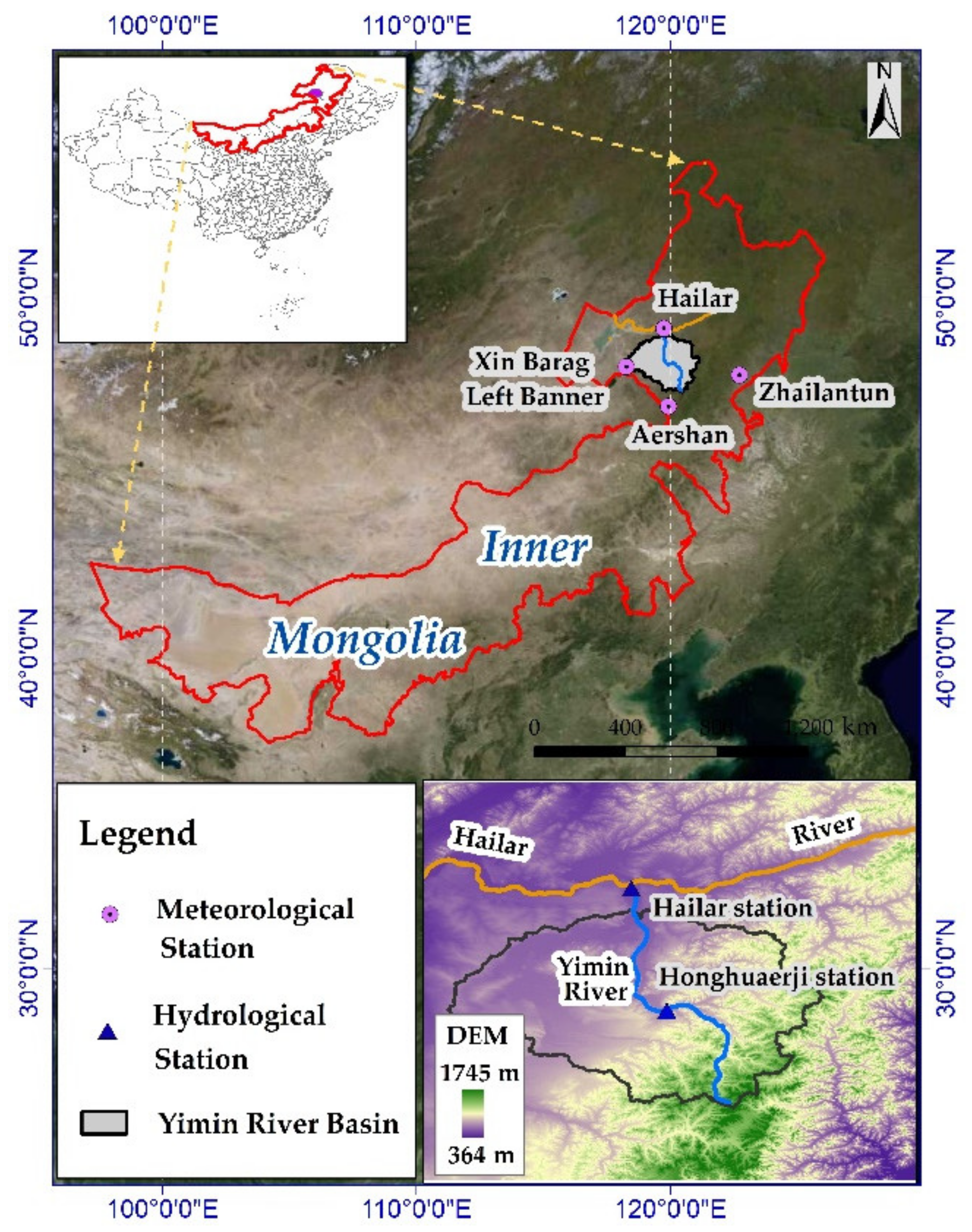
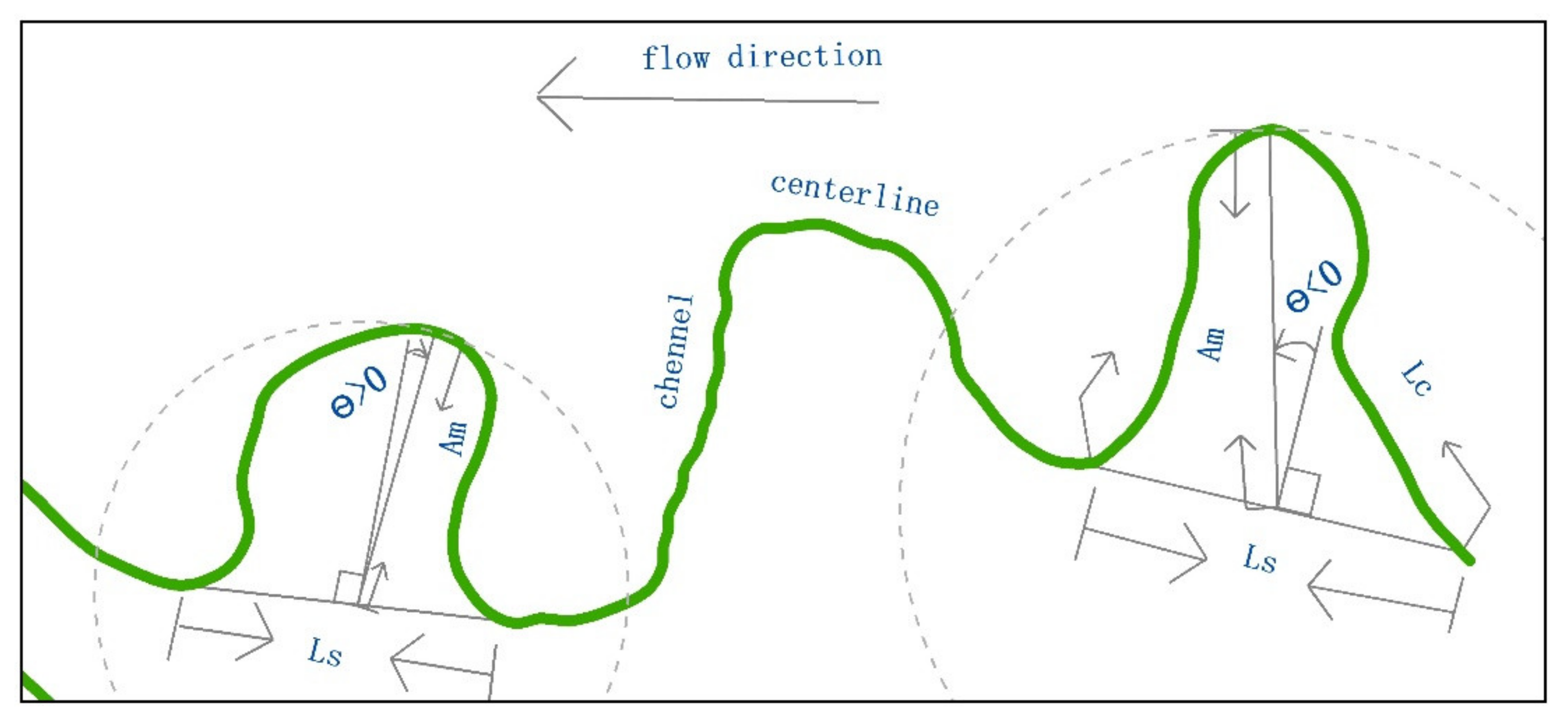
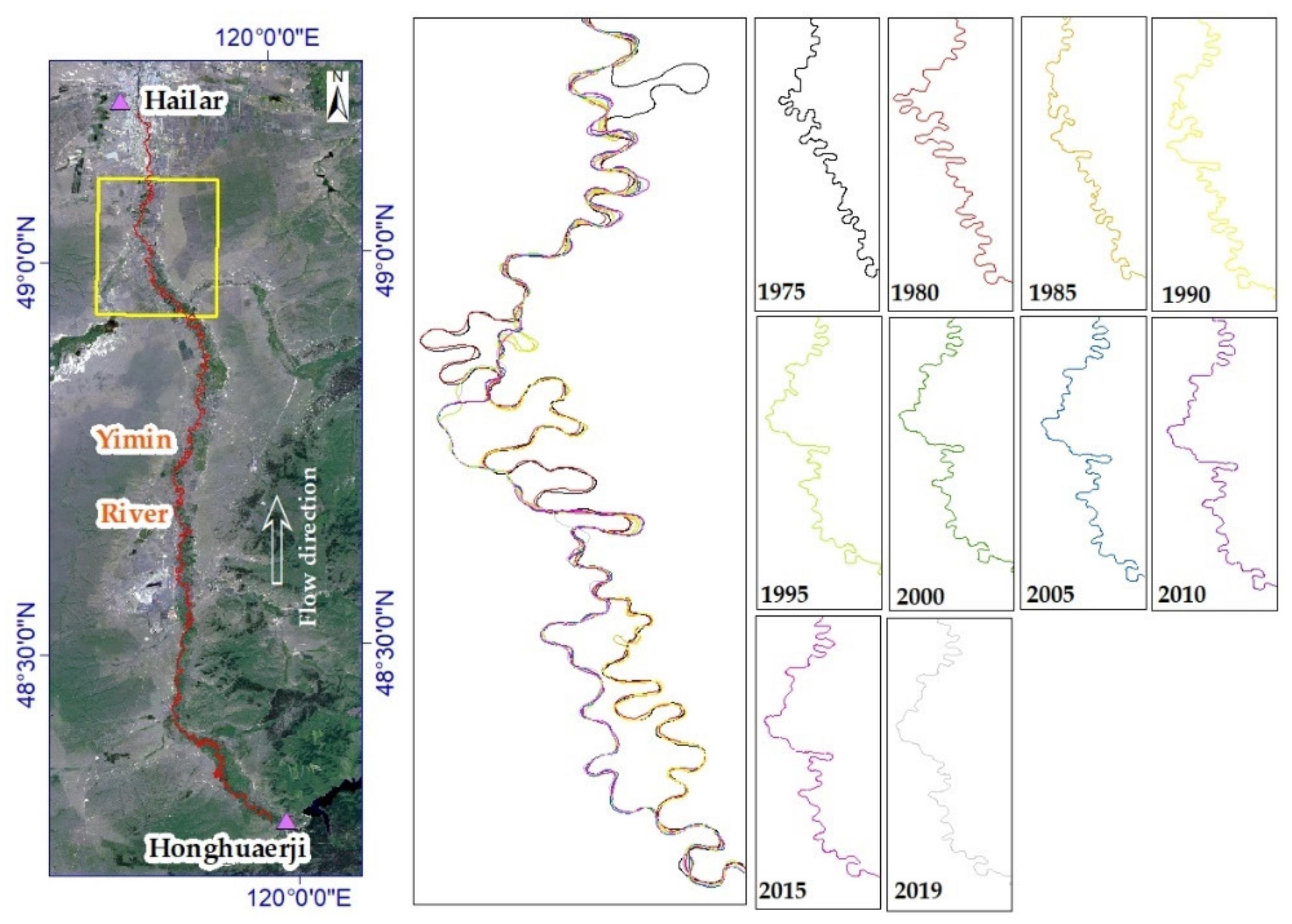
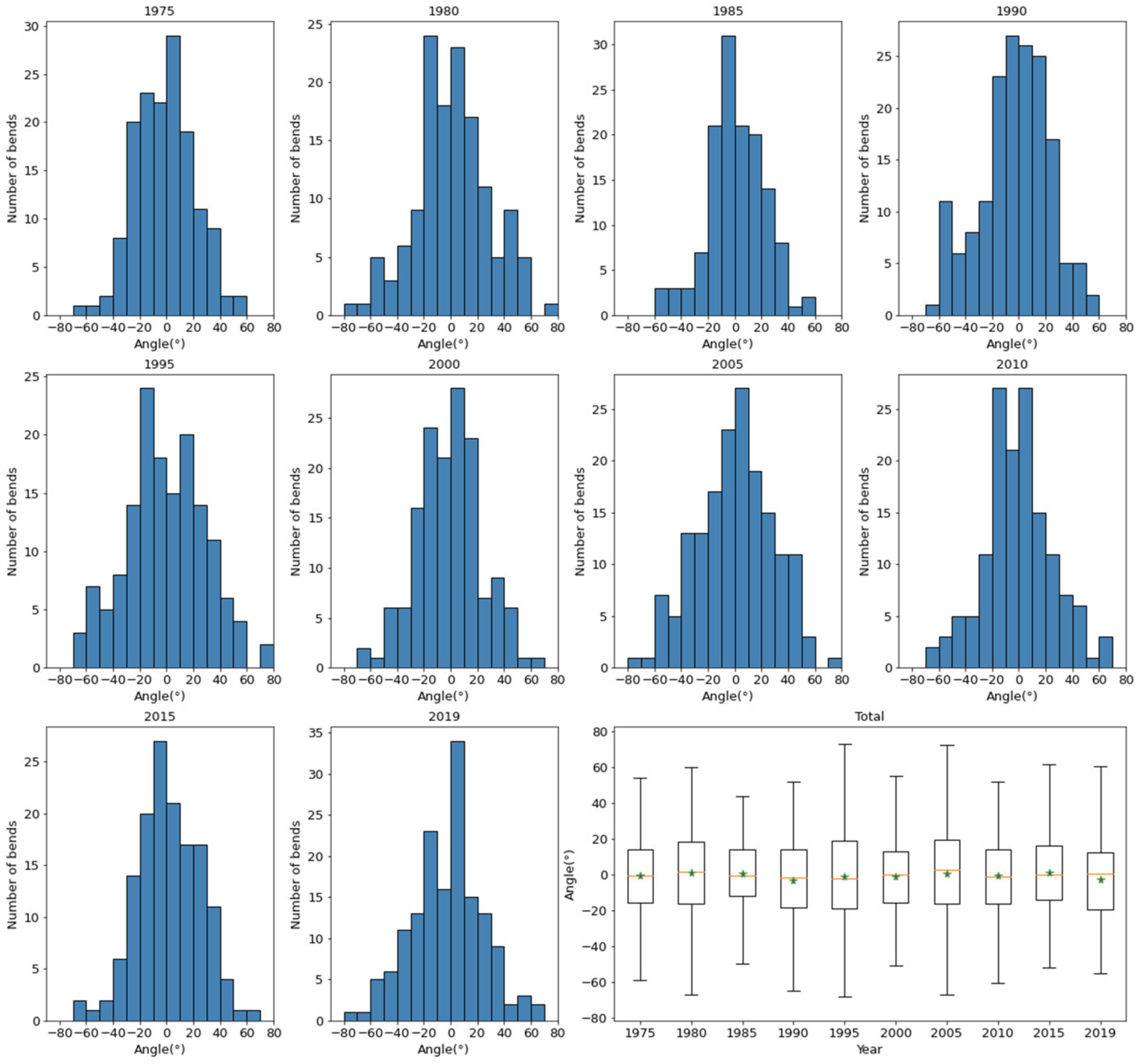
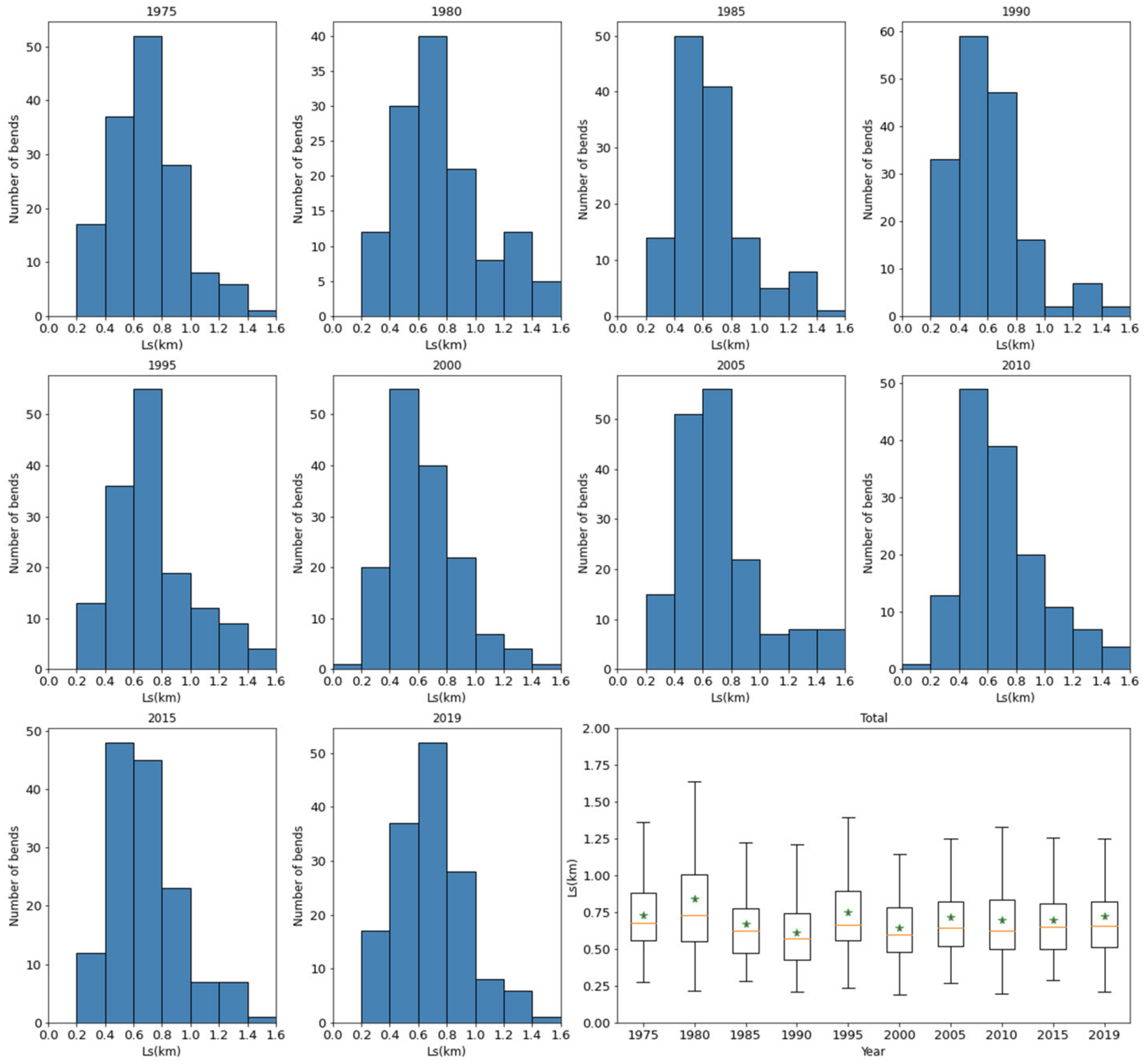
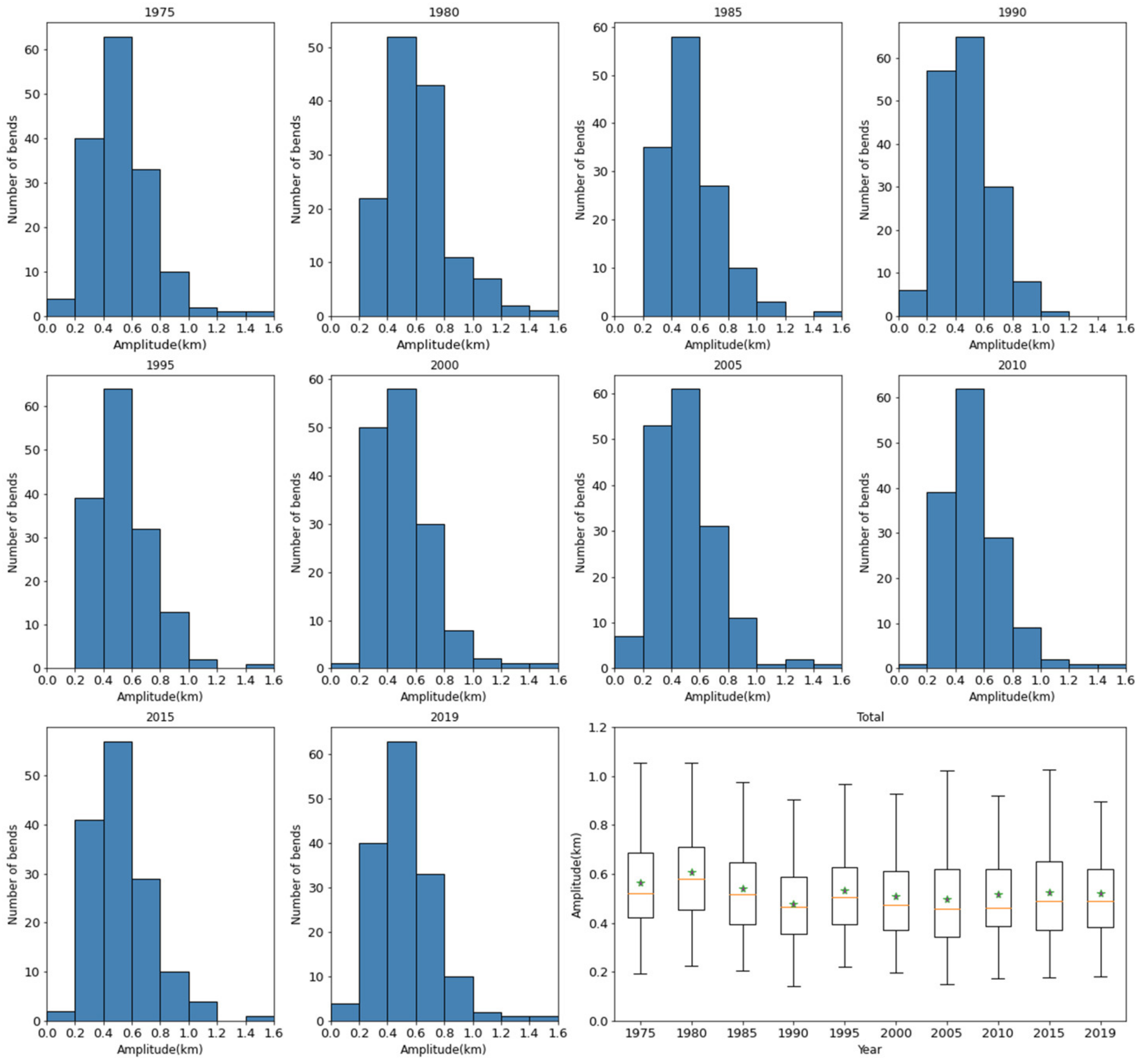
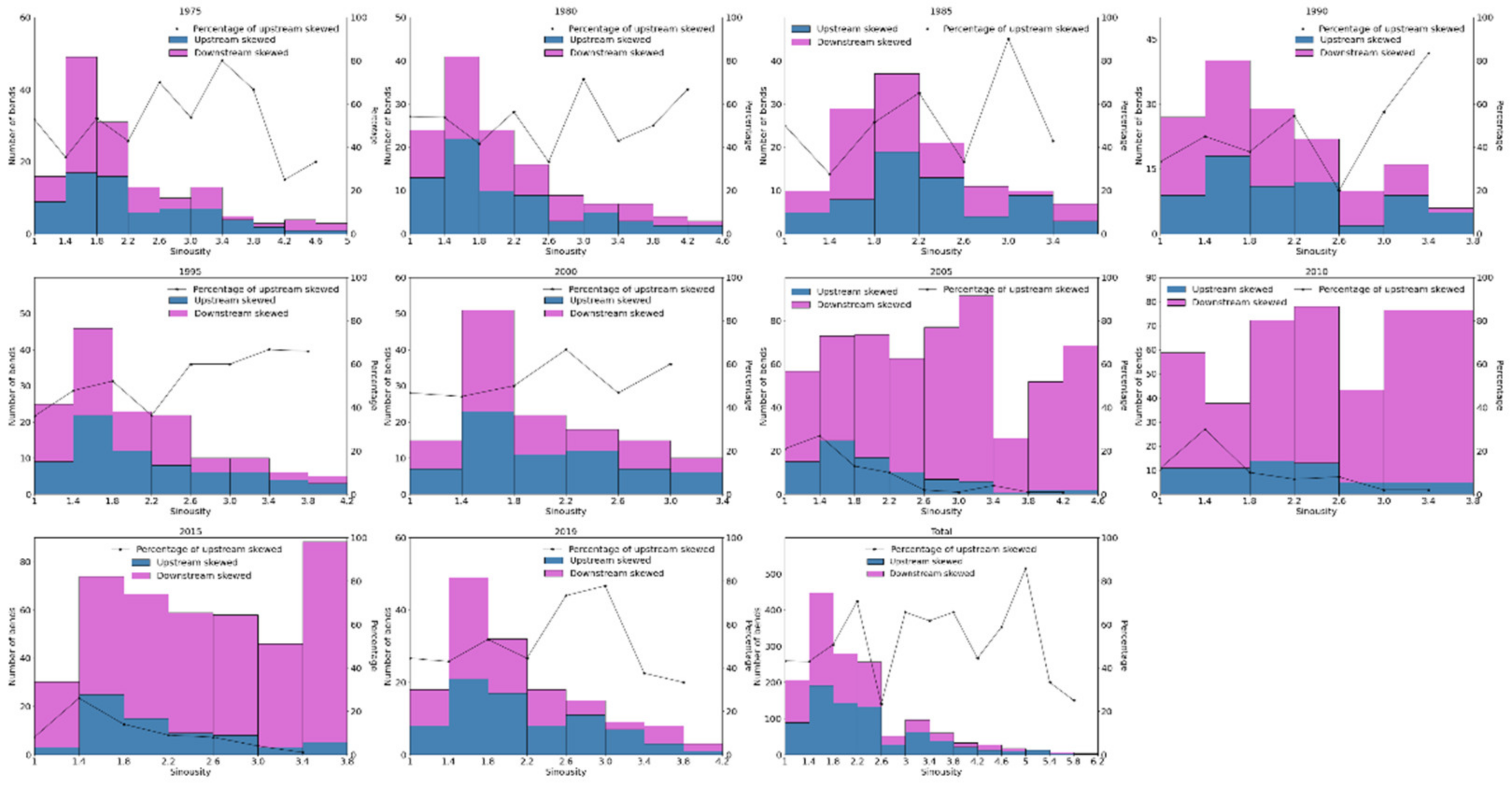
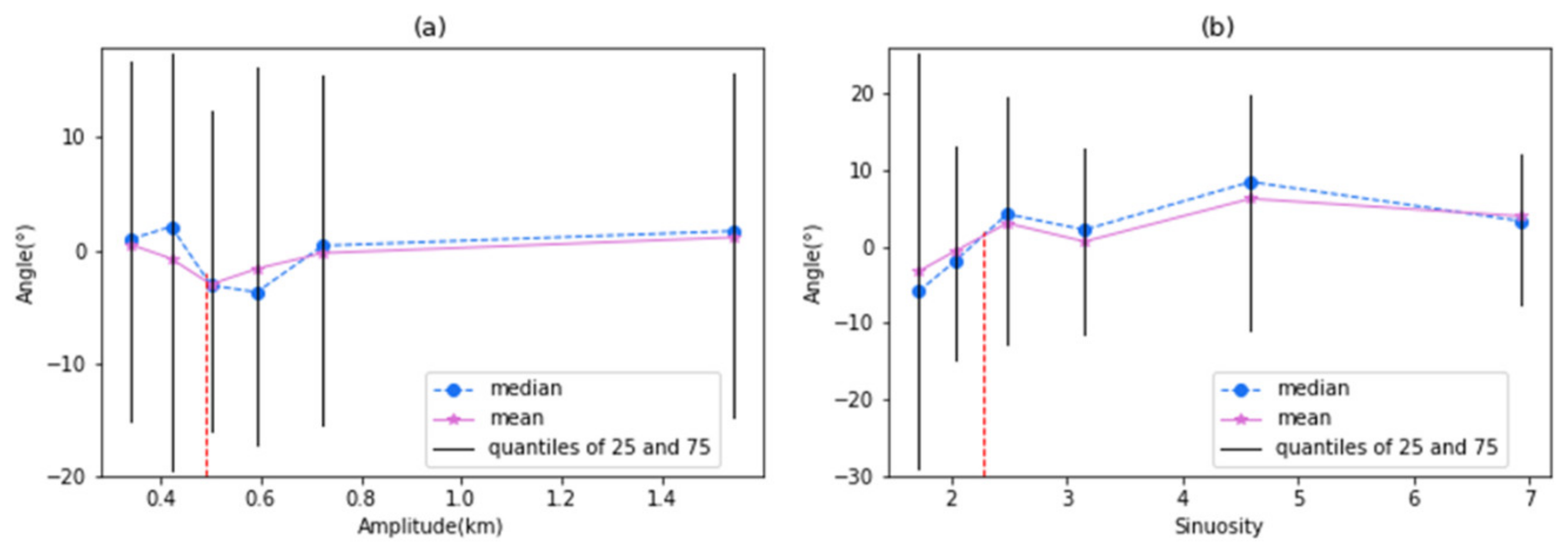
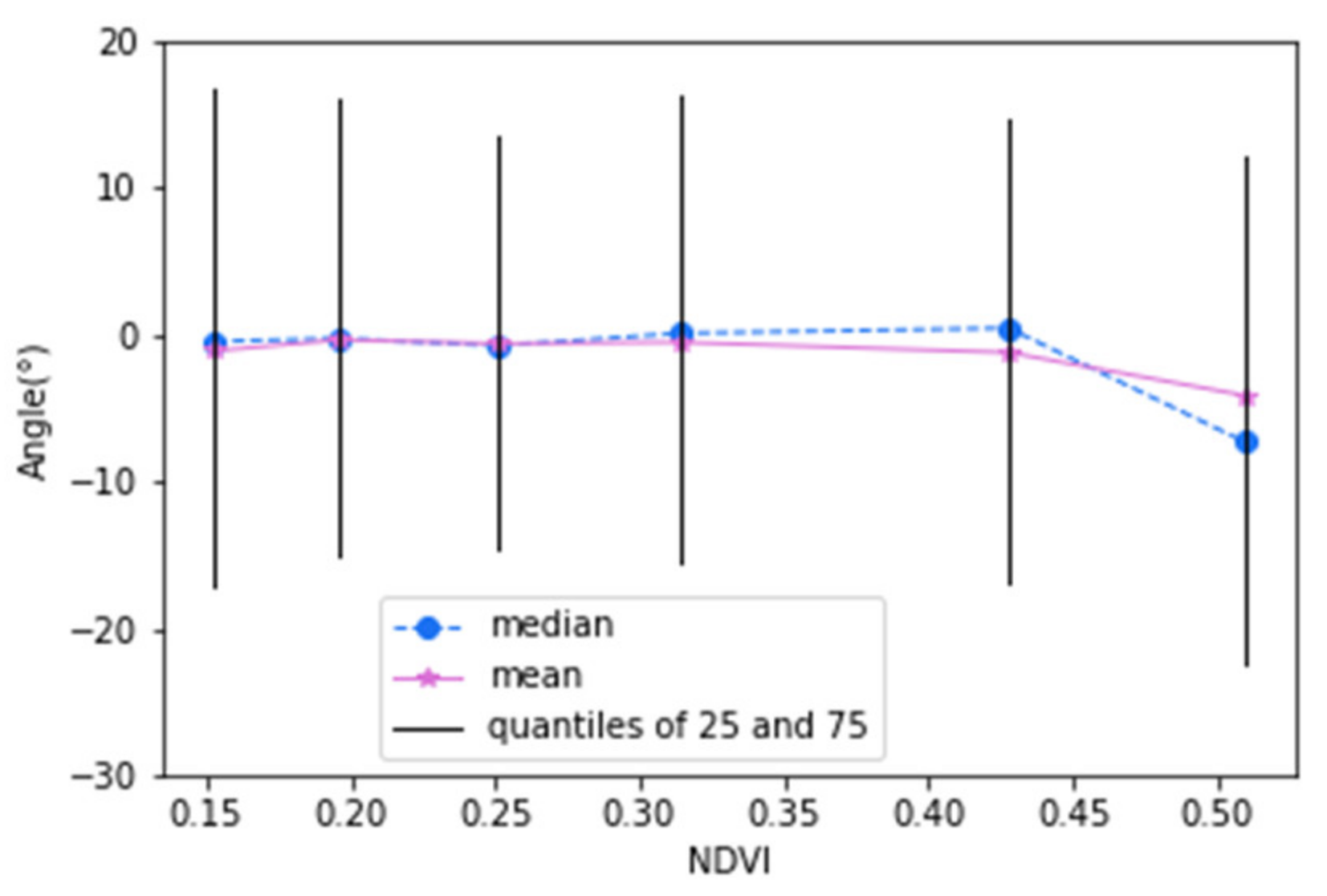
| 1980 | 1980–1990 | 1990 | 1990–2000 | 2000 | |
|---|---|---|---|---|---|
| Land-use type | Area (km2) | Percentage of changes (%) | Area (km2) | Percentage of changes (%) | Area (km2) |
| cropland | 20 | 0.1 | 21 | 1.6 | 33 |
| forest and grassland | 457 | −0.1 | 456 | −2.7 | 435 |
| urban area | 10 | 1.0 | 18 | −0.1 | 17 |
| bare area | 283 | −0.8 | 277 | 1.0 | 285 |
| 2000–2010 | 2010 | 2010–2020 | 2020 | 1980–2020 | |
| Land use type | Percentage of changes (%) | Area (km2) | Percentage of changes (%) | Area (km2) | Percentage of changes (%) |
| cropland | 1.4 | 44 | 0.1 | 45 | 3.2 |
| forest and grassland | −0.8 | 429 | −1.8 | 415 | −5.5 |
| urban area | 0 | 17 | 2.1 | 33 | 3 |
| bare area | −0.6 | 280 | 0 | 280 | −0.4 |
Publisher’s Note: MDPI stays neutral with regard to jurisdictional claims in published maps and institutional affiliations. |
© 2022 by the authors. Licensee MDPI, Basel, Switzerland. This article is an open access article distributed under the terms and conditions of the Creative Commons Attribution (CC BY) license (https://creativecommons.org/licenses/by/4.0/).
Share and Cite
Zhou, Y.; Tang, Q. Meandering Characteristics of the Yimin River in Hulun Buir Grassland, Inner Mongolia, China. Remote Sens. 2022, 14, 2696. https://doi.org/10.3390/rs14112696
Zhou Y, Tang Q. Meandering Characteristics of the Yimin River in Hulun Buir Grassland, Inner Mongolia, China. Remote Sensing. 2022; 14(11):2696. https://doi.org/10.3390/rs14112696
Chicago/Turabian StyleZhou, Yuanyuan, and Qiuhong Tang. 2022. "Meandering Characteristics of the Yimin River in Hulun Buir Grassland, Inner Mongolia, China" Remote Sensing 14, no. 11: 2696. https://doi.org/10.3390/rs14112696
APA StyleZhou, Y., & Tang, Q. (2022). Meandering Characteristics of the Yimin River in Hulun Buir Grassland, Inner Mongolia, China. Remote Sensing, 14(11), 2696. https://doi.org/10.3390/rs14112696







